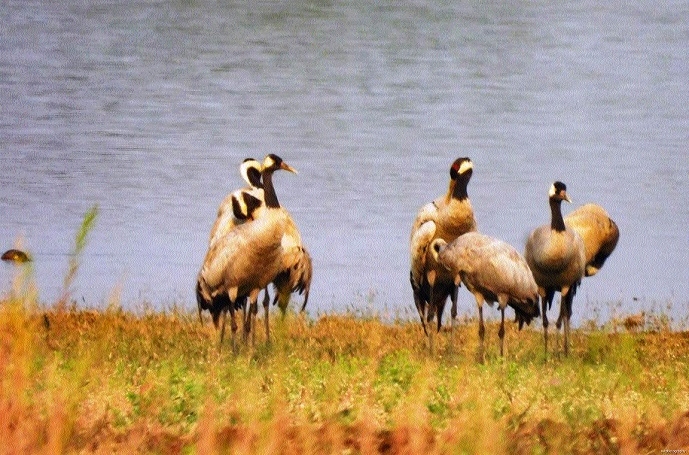Eurasian Crane spotted in CG
| Date :15-Feb-2021 |

Flock of cranes clicked by the SDM Avinash Bhoi and birder Pratik Thakur.
By Roshan Chachane :
RAIPUR,
In a significant discovery in the field of avian study, a team of birders and ornithologists captured the first photographs of a flock of Eurasian Cranes foraging for preys in and around a water body between Dongargarh and Khairagarh on Sunday. An avid birder and wildlife enthusiast SDM Dongargarh Avinash Bhoi told the team also comprising IFS Shashi Kumar, DFO Durg Dhammashil Ganvir, ornithologist Ravi Naidu spotted the Eurasian Cranes and captured the first photographic record of the Eurasian Crane or Common Crane (Grus Grus) from anywhere in Chhattisgarh. Ornithologist Ravi Naidu also ascertained the identification of Eurasian Crane by examining the photographs. Naidu also confirmed that the bird was never been in Chhattisgarh until now.
However, senior Ornithologist of Chhattisgarh AMK Bharos told that he had sighted birds at Kodar dam in 2004-05 and at Kasdol on the banks of Mahanadi long back. The birds were photographed at the water body, which was recently inspected by Durg Divisional Forest Officer (DFO) Dhammashil Ganvir, who observed that the region’s wetlands are a rich habitat for the birds. The common crane (Grus grus), also known as the Eurasian crane, is a bird of the family Gruidae, the cranes. A medium-sized species, it is the only crane commonly found in Europe besides the demoiselle crane (Anthropoides Virgo).
Along with the sandhill (Grus Canadensis) and demoiselle cranes and the brolga (Grus rubicunda), it is one of only four crane species not currently classified as threatened with extinction or conservation dependent on the species level. The Eurasian Crane species is one of the most widely distributed ones. They are mainly seen in the wild countryside. They make loud, trumpeting and penetrating calls which reach long distances. They stand around 115 centimetres with a wingspan of 180 to 200 cm and weighing in around 4.5 to 5.9 kilograms. These cranes breeds on greedy lakeshores, marshy clearings in the boreal forest of Northern Hemisphere with extremely cold temperatures and spend winters in wetlands. The throat, chin and chin are white, dark black to greyish in colours. Adults have a red patch on the top of head and eyes are bright red or reddish-brown.
They fly in V-formation with their necks outstretched. Eurasian Cranes forage with their beaks probing for small creatures in shallow water and land. These cranes perform gestures like bowing, bobbing, leaping, running or tossing of vegetation sometimes to show aggression and other time as a mating ritual. Generally, monogamous pairs of these cranes give co-ordinated simultaneous call while throwing their heads back and pointing their beaks upward. They generally use the same nest every year for breeding. The nests built arduously by both male and female of the pair on the top of a vegetation mound around the water body. They go through moult every biennially and become flightless for around one and a half month.